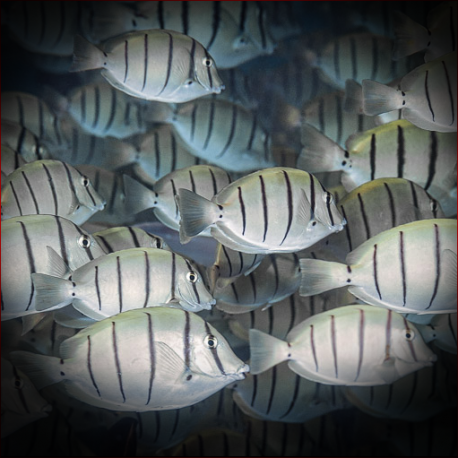More info
Datasheet
| Minimum Tank Size | 700 litres / 184.92 US gallons |
| Maximum Size | 26cm / 10.24inches |
| Reef Compatible | Always reef safe |
| Temperament | Peaceful |
| Temperature | 22.2°C / 71.96°F - 25.6°C / 78.08°F |
| Specific Gravity | 1.020-1.025 |
| Carbonate Hardness | 8-12 |
| pH | 8.1-8.4 |
General Description
The Convict Tang, scientifically known as Acanthurus triostegus, belongs to the Acanthuridae family and is also referred to as the Convict surgeonfish. These fish are adept at camouflaging themselves as juvenile Angelfish, making them difficult to distinguish from adult fish in images. They hail primarily from the Indo-Pacific region, excluding the seas around the Arabian Peninsula, and the lower Gulf of California to Panama in the Eastern Pacific.
Aquarium Suitability
Recognized for their peaceful temperament, Convict Tangs are considered suitable for most aquarium setups. They thrive in environments with well-established algae growth on rocks and stones, aiding in their dietary requirements and maintaining a healthy immune system. It is recommended to provide hiding spots, especially upon introducing them to a new aquarium, and ample space for swimming.
Demands, Care, and Hardiness
Convict Tangs exhibit an average level of hardiness and are effective algae-eaters, consuming significant amounts of algae types like green hair algae and filamentous algae. While they can coexist in large numbers, careful consideration should be taken when introducing multiple aggressive species into the same tank, as stress-related fatalities may occur. Maintaining a balanced diet of macroalgae and microalgae is crucial for their long-term health and well-being.
Reef Suitability
Convict Tangs are known to be reef-compatible and are generally considered reef-safe, seldom causing disturbances to corals or invertebrates. However, larger Palettes/Blue tangs may exhibit some exceptions to this behavior.
Aquarium Setup
When setting up an aquarium for Convict Tangs, it is essential to provide a tank size of at least 700 litres, with stable water conditions including a pH range of 8.1-8.4, a temperature of 22.2-25.6 degrees Celsius, and a specific gravity of 1.020-1.025. In addition to a well-established algae growth environment, incorporating sufficient hiding places and open swimming spaces is vital for their overall well-being.
Behaviour
In an aquarium setting, Convict Tangs typically spend their time swimming around and nibbling on algae-covered surfaces. They are known to establish hierarchies when housed with multiple species, with aggressive behaviors surfacing if not added cautiously.
Feeding and Diet
Convict Tangs primarily feed on small crustaceans such as krill, mysis, and artemia. Their diet should primarily consist of algae-based foods like seaweed or Nori, supplemented with Spirulina-based flakes to ensure their immune system remains robust.
Dimorphism and Habitat Distribution
Dimorphism in Convict Tangs, if present, is not detailed in the available information. These fish are commonly found in the East Indian Ocean, West Indian Ocean, Australia, The Red Sea, Indonesia, East Pacific, and Central/West Pacific regions, thriving in diverse marine habitats.

